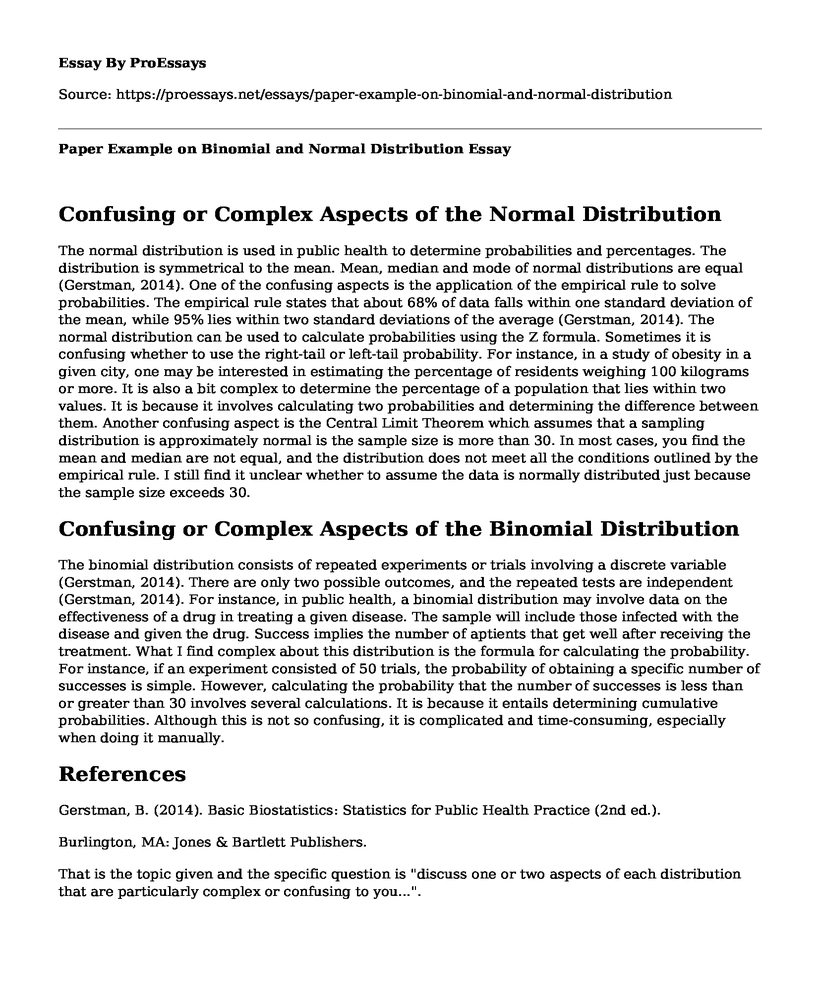Confusing or Complex Aspects of the Normal Distribution
The normal distribution is used in public health to determine probabilities and percentages. The distribution is symmetrical to the mean. Mean, median and mode of normal distributions are equal (Gerstman, 2014). One of the confusing aspects is the application of the empirical rule to solve probabilities. The empirical rule states that about 68% of data falls within one standard deviation of the mean, while 95% lies within two standard deviations of the average (Gerstman, 2014). The normal distribution can be used to calculate probabilities using the Z formula. Sometimes it is confusing whether to use the right-tail or left-tail probability. For instance, in a study of obesity in a given city, one may be interested in estimating the percentage of residents weighing 100 kilograms or more. It is also a bit complex to determine the percentage of a population that lies within two values. It is because it involves calculating two probabilities and determining the difference between them. Another confusing aspect is the Central Limit Theorem which assumes that a sampling distribution is approximately normal is the sample size is more than 30. In most cases, you find the mean and median are not equal, and the distribution does not meet all the conditions outlined by the empirical rule. I still find it unclear whether to assume the data is normally distributed just because the sample size exceeds 30.
Confusing or Complex Aspects of the Binomial Distribution
The binomial distribution consists of repeated experiments or trials involving a discrete variable (Gerstman, 2014). There are only two possible outcomes, and the repeated tests are independent (Gerstman, 2014). For instance, in public health, a binomial distribution may involve data on the effectiveness of a drug in treating a given disease. The sample will include those infected with the disease and given the drug. Success implies the number of aptients that get well after receiving the treatment. What I find complex about this distribution is the formula for calculating the probability. For instance, if an experiment consisted of 50 trials, the probability of obtaining a specific number of successes is simple. However, calculating the probability that the number of successes is less than or greater than 30 involves several calculations. It is because it entails determining cumulative probabilities. Although this is not so confusing, it is complicated and time-consuming, especially when doing it manually.
References
Gerstman, B. (2014). Basic Biostatistics: Statistics for Public Health Practice (2nd ed.).
Burlington, MA: Jones & Bartlett Publishers.
That is the topic given and the specific question is "discuss one or two aspects of each distribution that are particularly complex or confusing to you...".
Cite this page
Paper Example on Binomial and Normal Distribution. (2022, Jun 05). Retrieved from https://proessays.net/essays/paper-example-on-binomial-and-normal-distribution
If you are the original author of this essay and no longer wish to have it published on the ProEssays website, please click below to request its removal:
- Basing Nursing Practice on Evidence
- Changes in the Approach to Management Since the Industrial Revolution Essay
- Essential Fire Codes & Standards: A Safer Environment for the Public - Research Paper
- Essay Sample on Certification: Enhancing Nursing Faculty Career Growth & Quality Services
- Luxury Lifestyle Pre- and Post-Coronavirus: A Global Perspective - Essay Sample
- 2020: The Year Corona Virus Changed the World - Essay Sample
- ACCHS: Achieving Equality for First Nations People Through Equity - Essay Sample







